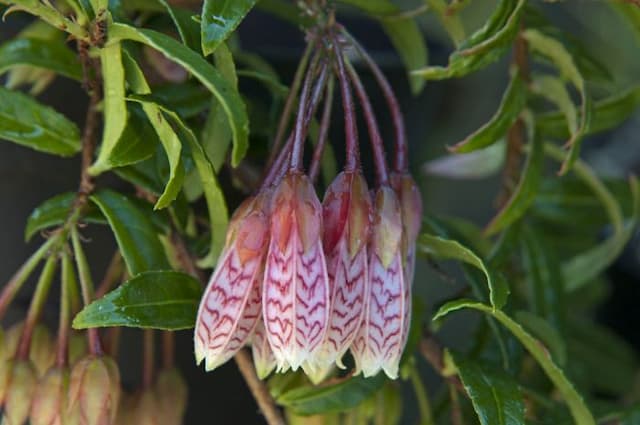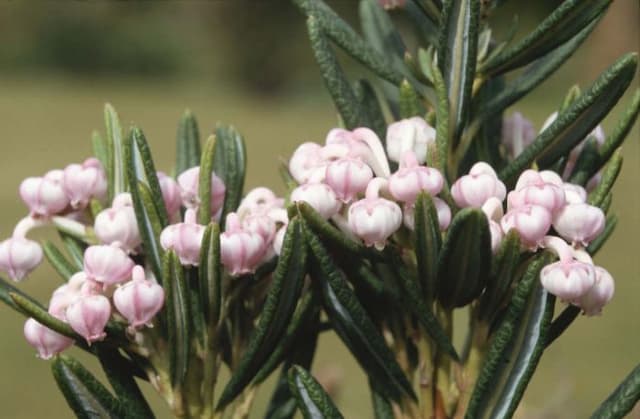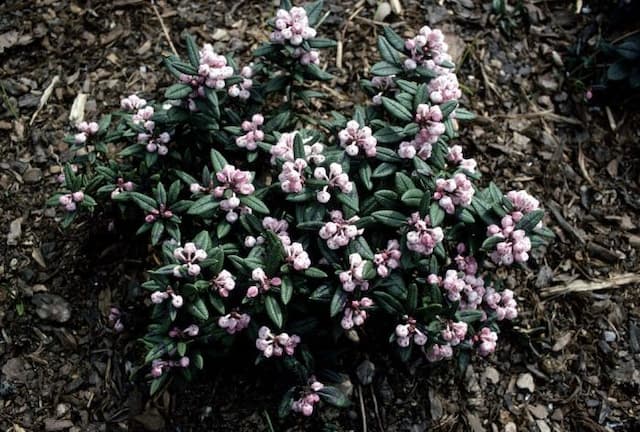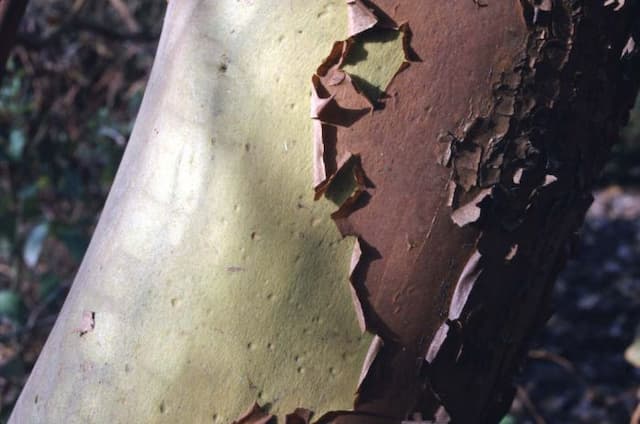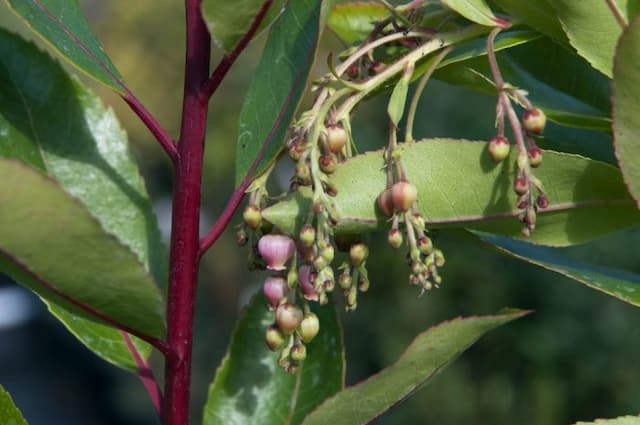Rhododendron Rhododendron 'Hoppy'
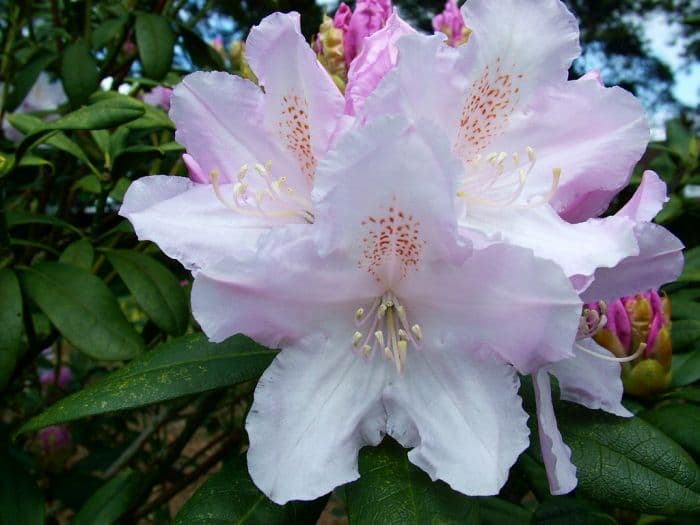
ABOUT
The Rhododendron 'Hoppy' is known for its showy floral display and attractive foliage, making it a standout in gardens where it's grown. This plant is adorned with clusters of bell-shaped flowers that come in a vibrant shade, often ranging from pink to purple, depending on the cultivar. The blooms are known for their brightness and are frequently speckled or patterned with contrasting colors in the throat, adding depth and interest to the overall appearance. The leaves of the 'Hoppy' are leathery and evergreen, providing a year-round visual appeal. They are typically elongated with a smooth, glossy surface and a deep green color that serves as a perfect backdrop to the eye-catching flowers. The foliage might also turn to an attractive hue in colder months, contributing to the plant's seasonal interest. Rhododendron 'Hoppy' has a bushy and dense habit, making it a good choice for a focal point in landscaping. Its structure is rounded, with branches that display a spreading pattern. The combination of its stunning blooms, lush foliage, and symmetrical shape give it a very ornamental quality, ensuring that it makes a strong visual impact in any setting where it is planted. Overall, the appearance of Rhododendron 'Hoppy' is defined by its lush, vibrant flowers that burst into color during their blooming season and its glossy, deep green leaves that provide a rich texture and color throughout the year. Its appearance changes subtly with the seasons, offering a dynamic presence in the garden.
About this plant
 Names
NamesFamily
Ericaceae
Synonyms
Hoppy Rhododendron
Common names
Rhododendron 'Hoppy'.
 Toxicity
ToxicityTo humans
Rhododendron 'Hoppy' is a variety of rhododendron. All parts of the rhododendron plant are known to be toxic to humans if ingested. The plant contains grayanotoxins, which can disrupt sodium channels affecting the skeletal and cardiac muscle. Symptoms of rhododendron poisoning may include vomiting, diarrhea, hypersalivation, weakness, coma, hypotension, CNS depression, cardiovascular collapse, and potentially death if a significant amount is consumed.
To pets
Rhododendron 'Hoppy' is also toxic to pets, including dogs and cats. Similar to humans, the ingestion of any part of a rhododendron plant can cause pets to suffer from symptoms such as vomiting, diarrhea, drooling, weakness, collapse, coma, hypotension, and potentially death. The toxic principle is the same, being mainly due to grayanotoxins affecting cardiac and skeletal muscles. Immediate veterinary care is recommended if a pet is suspected of ingesting rhododendron.
 Characteristics
CharacteristicsLife cycle
Perennials
Foliage type
Evergreen
Color of leaves
Green
Flower color
Pink
Height
4 feet (1.2 meters)
Spread
4 feet (1.2 meters)
Plant type
Shrub
Hardiness zones
5
Native area
Asia
Benefits
 General Benefits
General Benefits- Ornamental Value: Rhododendron 'Hoppy' is widely appreciated for its attractive flowers and foliage, which add beauty to gardens and landscapes.
- Habitat Support: It provides food and shelter for various species of insects and birds, contributing to biodiversity.
- Shade Tolerance: As a rhododendron, this plant is capable of growing in shaded areas where other plants might not thrive, enabling gardeners to decorate darker spots.
- Seasonal Interest: With its distinctive blooms, it adds a splash of color in the spring and has evergreen leaves that provide year-round greenery.
- Privacy and Screening: The plant can be used as a natural privacy barrier or to screen unpleasant views when planted in groups or as a hedge.
- Erosion Control: Rhododendrons, including 'Hoppy', have root systems that help stabilize soil on slopes, preventing erosion.
- Durable and Low Maintenance: Once established, it requires minimal care, thus suitable for gardeners seeking low-maintenance landscaping solutions.
- Attracts Pollinators: The flowers of Rhododendron 'Hoppy' attract pollinators such as bees and butterflies, which are essential for the pollination of many plants.
 Medical Properties
Medical PropertiesThis plant is not used for medical purposes.
 Air-purifying Qualities
Air-purifying QualitiesThis plant is not specifically known for air purifying qualities.
 Other Uses
Other Uses- Rhododendron's leaves can be used to create a natural dye, giving fabrics and materials a range of beautiful colors, particularly yellow and green hues.
- The wood of Rhododendron is sometimes utilized in the creation of small wooden items or tools due to its hardness and density.
- Some cultures use the Rhododendron flower petals to concoct vibrant and decorative inks for art and calligraphy.
- In some regions, Rhododendron is a source of food for honey bees, producing a unique and sometimes toxic honey known as "mad honey."
- During festive seasons, the foliage and flowers of the Rhododendron might be used to make natural garlands and wreaths.
- Rhododendron leaves can be used as a green mulch, providing nutrients back to the soil as they decompose.
- Gardeners sometimes plant Rhododendron as a companion plant to provide shade and protection to more sunlight-sensitive plants.
- Beyond its decorative uses, Rhododendron branches can be shaped into natural fencing or border edges in landscaping projects.
- The plant's thick leaves can serve as a kind of natural scrubbing tool for cleaning pots and pans in outdoor or rustic settings.
- Some creative artists may use the Rhododendron's varied forms as inspiration or actual models in the design of jewelry, such as brooches or pendants.
Interesting Facts
 Feng Shui
Feng ShuiThe Rhododendron is not used in Feng Shui practice.
 Zodiac Sign Compitability
Zodiac Sign CompitabilityThe Rhododendron is not used in astrology practice.
 Plant Symbolism
Plant Symbolism- Warning: Rhododendrons can symbolize caution or danger as some species are poisonous when ingested.
- Beware: Similarly, they can represent a warning to be wary about something that might appear safe but has hidden risks.
- Abundance: These plants have lush, full blooms, often symbolizing abundance or wealth.
- Temperance: The Rhododendron is also associated with moderation or the need to take things in moderation, possibly due to its toxic nature when over-consumed.
- Elegance: With their showy flowers, they often represent elegance and the beauty found in nature.
- Survival: Rhododendrons are hardy plants that can survive in challenging environments, symbolizing the ability to persevere through hardships.
 Water
WaterAzaleas, including the Rhododendron 'Hoppy', prefer moist, well-drained soil, so it's important to water them deeply. During the growing season, water your azalea once a week with about 1 gallon of water per plant, ensuring the soil is moist but not soggy. Increase the frequency to twice a week during hot, dry periods. In the fall and winter, reduce watering to every two weeks if there's no rain. If the azalea is potted, ensure the container has drainage holes to prevent root rot.
 Light
LightAzaleas thrive in dappled sunlight or partial shade. Ideally, place the Rhododendron 'Hoppy' in a spot where it can receive morning sunlight and afternoon shade. Avoid direct afternoon sun, especially in hotter climates, as it can scorch the leaves and stress the plant. A location under the filtered light of tall trees is often ideal.
 Temperature
TemperatureAzaleas like Rhododendron 'Hoppy' are generally hardy and can withstand minimal winter temperatures down to about -10 to -20 degrees Fahrenheit. The ideal temperature range for growing azaleas is between 50 and 70 degrees Fahrenheit during their active growing months. They can survive brief dips into the 30s but try to avoid exposure to extreme cold for extended periods.
 Pruning
PruningAzaleas, including the Rhododendron 'Hoppy', should be pruned to maintain shape and encourage bushier growth. Prune right after the blooming period, typically in late spring or early summer, as azaleas set next year's flower buds shortly after the current season's flowers fade. Remove dead or crossing branches, and shape the plant as desired.
 Cleaning
CleaningAs needed
 Soil
SoilThe best soil mix for a Rhododendron, commonly known as Azalea, is well-draining, high in organic matter, and slightly acidic with a pH of 4.5 to 6.0. A mix can be made from equal parts peat moss, pine bark, and perlite to ensure good drainage and moisture retention.
 Repotting
RepottingAzaleas should typically be repotted every 2 to 3 years to prevent root-bound conditions and to refresh the growing medium. It's best to repot in the late winter or early spring before new growth begins.
 Humidity & Misting
Humidity & MistingAzaleas thrive in environments with high humidity, ideally between 40% to 60%. They benefit from occasional misting or a humidity tray to maintain the best humidity levels around the plant.
 Suitable locations
Suitable locationsIndoor
Ensure bright, indirect light, and high humidity for indoor Azaleas.
Outdoor
Plant in partial shade with moist, acidic soil for outdoor Azaleas.
Hardiness zone
5-9 USDA
 Life cycle
Life cycleThe Rhododendron 'Hoppy', commonly known as the hoppy rhododendron, begins its life cycle when a seed germinates in well-drained, acidic soil, typically in partial to full shade. The seedling grows slowly, developing an extensive root system and a woody stem, and after several years, it matures into a shrub with a lush foliage of leathery leaves. Seasonally, usually in late spring, the hoppy rhododendron produces clusters of showy flowers that can range from pink to purple, attracting pollinators such as bees and butterflies. After pollination, the flowers develop into seed capsules that eventually dry and release seeds, continuing the reproductive cycle. Throughout its life, the hoppy rhododendron undergoes periods of dormancy during the winter months, where growth ceases and the plant conserves energy. With proper care, including protection from harsh conditions and pests, this rhododendron can live for many years, frequently several decades, embellishing landscapes with its evergreen beauty.
 Propogation
PropogationPropogation time
Spring-Early Summer
Propogation: The Rhododendron 'Hoppy', commonly known as a type of Rhododendron, can be propagated by cuttings, which is the most popular method for this plant. The best time to take cuttings for propagation is typically in the late summer or early autumn. To propagate Rhododendron 'Hoppy' from cuttings, one should select healthy, semi-ripe stems from the current year’s growth. Cut a 4 to 6 inch (about 10 to 15 centimeters) section of stem just below a node, remove the lower leaves, and dip the cut end into a rooting hormone. Then insert the cutting into a pot filled with a mix of peat and perlite to ensure good drainage and aeration. The pot should be kept in a warm location with indirect sunlight and the soil should be kept consistently moist but not waterlogged. Roots typically develop within a few weeks to months, after which the new Rhododendron 'Hoppy' plants can be transplanted into individual pots or into the ground.
